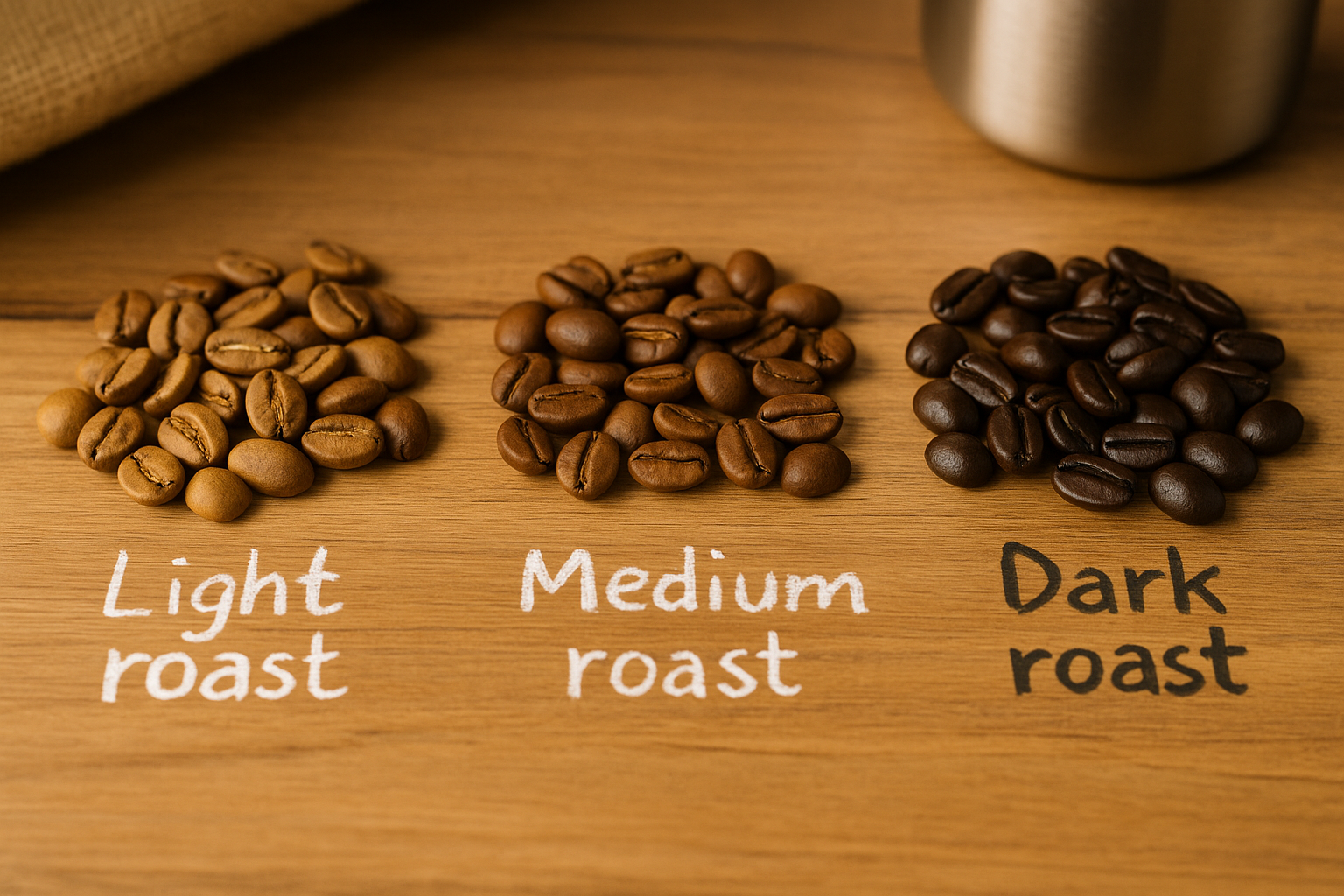Coffee roasting transforms raw green beans into the aromatic, flavorful products we brew every day.
For baristas, understanding how different roast levels affect a coffee’s taste, aroma, texture, and behavior in brewing is essential for consistency and excellence.
Your role as a barista goes beyond pressing buttons. Knowing the differences between light, medium, and dark roasts equips you to make better drinks, educate customers, and troubleshoot extractions when flavor isn’t quite right.
What Happens During the Roast?
Coffee roasting is a chemical transformation. As green coffee is exposed to heat, a series of complex reactions begins. Sugars caramelize, acids evolve, and new aromatic compounds form.
The most important chemical process is the Maillard reaction, which creates the brown color and thousands of flavor notes. There’s also caramelization, where sugars break down into rich, sweet flavors.
The roast level determines how far these reactions go. Lighter roasts preserve more of the bean’s origin character. Darker roasts push flavor toward bitterness and boldness, reducing acidity and sweetness.
Light Roasts: Bright, Fruity, and Complex
Light roasts are typically roasted until just after the first crack, when moisture in the beans causes them to pop. These roasts keep much of the original bean character, including its acidity, fruitiness, and delicate notes.
The color is usually tan or light brown. The surface of the beans appears dry, with no visible oil.
In the cup, light roasts often feature citrus, berry, or floral flavors. Their high acidity and clarity make them ideal for manual brews like pour-overs or Aeropress.
As a barista, expect light roasts to extract faster and require precision in temperature and grind size. They’re unforgiving of mistakes but rewarding when done right.
Medium Roasts: Balanced and Versatile
Medium roasts reach just before or after the second crack, depending on the style. They balance acidity, body, and sweetness, making them a popular choice for both filter coffee and espresso.
The beans are medium brown and still dry on the surface. The flavor profile includes chocolate, caramel, and gentle fruit notes.
Medium roasts work well across many brewing methods. They tend to be more forgiving and easy to dial in, which makes them a favorite for café menus and blends.
For baristas, medium roasts offer flexibility. You can highlight sweetness in espresso or bring out balance in milk drinks like flat whites or cappuccinos.
Dark Roasts: Bold, Bitter, and Full-Bodied
Dark roasts are taken well into or past the second crack, where oils start to appear on the bean surface. These roasts develop intense caramel, smoky, and even ashy flavors.
Origin characteristics are mostly lost in dark roasts. Acidity is low, bitterness is high, and the body is heavy.
They’re popular among customers who prefer a strong, bold cup. Espresso blends with Robusta often fall into this category to maximize crema and caffeine impact.
As a barista, expect to grind finer and use lower brew temperatures to reduce harshness. Dark roasts can over-extract quickly if not carefully managed.
Visual and Physical Clues for Roast Identification
Baristas should be able to identify roast levels by sight, smell, and touch. Here’s how:
- Light Roast: Light brown color, dry surface, strong aroma of fruit or tea.
- Medium Roast: Medium brown, balanced scent of toast, nuts, or chocolate.
- Dark Roast: Dark brown or black, shiny surface, intense aroma of smoke or cocoa.
You can also feel the beans. Light roasts are denser and harder to grind. Dark roasts are brittle and tend to produce more fines.
How Roast Impacts Brewing Variables
Roast level directly affects how you brew. Here’s how to adjust based on roast:
- Grind Size: Light roasts may need finer grinds for proper extraction. Dark roasts usually require coarser grinds to avoid over-extraction.
- Water Temperature: Use 93–96°C for light roasts to extract delicate acids. For dark roasts, lower the temperature to 88–92°C.
- Brew Time: Light roasts benefit from slightly longer extraction times. Dark roasts need shorter times to prevent bitterness.
- Ratio: For espresso, dark roasts often perform better at higher ratios like 1:2.5. For light roasts, tighter ratios help highlight clarity.
Mastering these adjustments means you’ll consistently deliver better coffee, regardless of what roast is in your hopper.
Roast Profiles and Espresso Behavior
Espresso reacts dramatically to roast level. Light-roast espresso is a trend in specialty cafés, but it’s difficult to execute. It often requires longer pre-infusions and precise dialing to avoid sourness.
Medium-roast espresso is more user-friendly. It gives you balanced shots that work well with or without milk. It’s the go-to for consistency and wide customer appeal.
Dark-roast espresso brings boldness, bitterness, and body. It pairs well with milk and sugar but must be extracted carefully to avoid excessive harshness.
Understanding how roast interacts with pressure, yield, and water helps you make better decisions at the machine.
Communicating Roast Profiles to Customers
Many customers don’t understand what roast level really means. They often confuse “dark roast” with “strong coffee” or assume “light roast” is weak.
Use descriptive language to help them. For example:
- “This light roast is citrusy and bright, with a tea-like finish.”
- “Our medium roast is smooth and balanced, with notes of chocolate and almond.”
- “The dark roast is bold, full-bodied, with deep cocoa and a smoky finish.”
When customers taste something they enjoy, tie it back to the roast level so they learn what to look for next time.
Matching Roast to Brewing Method
Each brewing method interacts with roast levels differently. Here’s a guide:
- Pour-Over: Best for light to medium roasts. Brings out clarity and complexity.
- Espresso: Works with all roast levels, but each needs dialing. Medium is most forgiving.
- French Press: Great for medium and dark roasts. Emphasizes body and sweetness.
- Cold Brew: Often brewed with medium to dark roasts. Produces low-acid, smooth results.
- Moka Pot: Works well with medium-dark roasts. Can emphasize roast bitterness if overdone.
Matching the right roast to the brew method makes a huge difference in customer satisfaction.
Roast Freshness and Degassing
Freshly roasted beans contain trapped CO₂ gas, which affects brewing. Lighter roasts degas more slowly due to their density, while darker roasts degas faster.
For espresso, wait 7–14 days after roasting for optimal performance. For filter coffee, 4–10 days is usually sufficient.
Always check roast dates and adjust your dose and grind based on how recently the beans were roasted. Degassing affects extraction, crema, and flavor stability.
Blending Different Roast Levels
Some cafés experiment with blending different roast levels to create complexity. For example, a blend might include:
- 70% medium-roast Colombian for sweetness and balance.
- 30% light-roast Ethiopian for brightness and acidity.
These blends offer the best of both worlds but require careful recipe design. Roast blending can also extend the shelf life and broaden customer appeal.
Baristas who understand how different roast levels interact can help design or adjust blends for optimal performance.
Roast and Milk Pairings
In milk-based drinks, roast plays a major role. Lighter roasts may get lost in cappuccinos unless they’re high-acid and high-density. Medium roasts tend to pair best with milk, offering a round, sweet flavor.
Dark roasts hold up in milk but can dominate the drink with bitterness if not brewed precisely.
Use taste tests to find the right roast for your café’s milk drinks. Serve espresso and milk side by side and note what flavors carry through.
Final Thoughts: Mastering Roast as a Barista
Roast level is one of the most powerful variables in coffee flavor. By understanding how light, medium, and dark roasts behave in the grinder, in the brewer, and in the cup, you become a more skilled and confident barista.
Stay curious. Taste new roasts regularly. Ask roasters about their profiles. Experiment with brewing and adjust based on what you learn.
The more fluent you become in roast language, the better you’ll serve your customers—and the closer you’ll get to perfecting your craft.

Artur is a coffee enthusiast and content creator passionate about barista techniques and coffee culture. With a sharp eye for detail and a love for learning, he shares practical tips, brewing guides, and gear insights to help readers elevate their coffee experience — from home brewers to aspiring professionals.
